Squares Arsenal | Hunchback | Dogana | Colleoni | Rioba | Piazzetta St. Mark | Stefano | Rialto Vecchio
Sior Antonio Rioba, the Statues of the Mastelli Brothers at Campo dei Mori in Venice
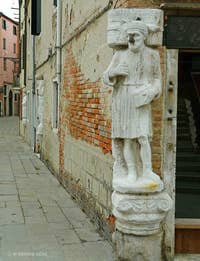
The Mastelli Brothers In Venice's Cannaregio, on the corner of Campo dei Mori and the Fondamenta of the same name, along the Río de la Sensa, are four Oriental-looking statues.
These statues, three of which are said to represent the Mastelli brothers, have undergone multiple vicissitudes and modifications over the course of their history, a history that begins nine centuries ago, in 1112!
It was in fact in 1112 that three Greek merchants, originally from Morea (the ancient name for the Greek Peloponnese), came to settle in Venice.
The word Mori therefore has absolutely nothing to do with the Moorish, contrary to what many authors have claimed.
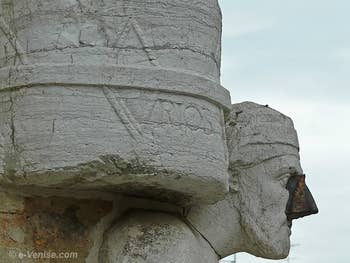
Rioba Mastelli Moreover, there is no source indicating that these three Greek merchants may have had dark rather than white skin.
The surname that these Peloponnesian Greeks adopted as Venetians, Mastelli, is said to refer to the baquets of silver and other coins that legend says they brought with them.
Their integration into the Venetian commercial and civic community went off without a hitch, proof of how open-minded the Republic of Venice was at the time, an openness that was the source of its success over the centuries of its long history.
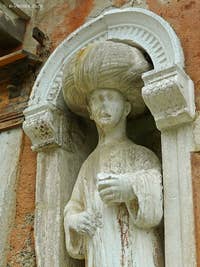
The Servant of the Mastelli Brothers Indeed, not only were the Mastellis able to settle in Venice without difficulty to grow and develop their trade, but they were even admitted to sit on the Grand Council of the Republic.
We also know that the Mastelli took part in the great Crusade of 1202, led by Doge Enrico Dandolo, the one that led to the capture of Constantinople.
It was also thanks to its participation in the Great Crusade that the Mastelli family was able to obtain the same commercial rights as other Venetian citizens.
The right to arm their own ships, to organise the transport of goods, but also to sell their products in Venice under their own sign, that of a fier camel, a sign that their trade extended as far as the Near East, like that of many other Venetians for that matter.
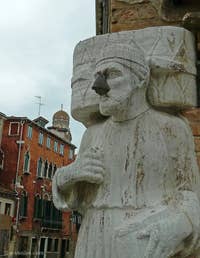
Rioba and his iron nose This trade reaching as far as the Near East is symbolised by a camel that can still be seen today on the palazzo Mastelli, whose facade faces the other end of campo dei Mori, on the rio dell'Madonna dell'Orto.
To get a small idea of the wealth of this family, it is worth knowing that the Mastelli brothers owned all the buildings between the rio de la Madonna de l'Orto and the rio de la Sensa, the whole bordered on the left by the campo and calle dei Mori and on the right by their palazzo and the house that later became that of Jacopo Robusti, known as Tintoretto.
The house itself of Tintoret, before becoming that artist's on 8 June 1574, was in fact one of the Mastelli brothers' properties, a fact confirmed by the presence of one of the four oriental statues, embedded in the left-hand side of its facade.
The Sculptures by Rioba, Afani and Sandi Mastelli in Venice

Afani or Sandi
Four Statues for Three Brothers
The three Mastelli brothers who arrived from Morea were called Rioba, Sandi and Afani.It is their statues that stand on the Campo dei Mori, with that of Rioba, the most famous, on the corner of the Fondamenta, just opposite the bridge.
As for the fourth, the one on the side of the house of the Tintoretto, it would in fact be their servant.
These large statues (from 1m50 to 1m90 for the largest) were not installed by the Mastelli brothers themselves but nearly two centuries after their arrival in Venice since they are dated to the late 13th century, or even the early 14th century.
Originally, these statues, made of Istrian stone, did not have the appearance they have today either.

The Servant of the Mastelli brothers In fact, it was not until almost two centuries after the statues were installed, at the end of the 15th century, that they found themselves dressed in turbans, turbans that are not, incidentally, made of Istrian stone like the statues they cap, but carved from Greek marble.
So our beloved traders from the Morea didn't really become Oriental until almost four centuries after they arrived in Venice!
But that's not the only strange feature about the dei Mori statues.
They are in fact all placed on remains of pillars from the Roman era. Which makes each of them a rather unusual historical puzzle.
As to why the famous turbans were added, no evidence has been found to explain the transformation.
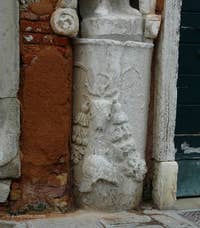
Column of the fourth statue Nor the reason why all four have lost their noses... no doubt due, alas, to deliberate damage.
These four statues have also lost... their colours.
All the ancient chronicles report that they were indeed painted, which must have given them an even very different look!
What is accepted, however, is that the location where they stood must have encircled the commercial part of the Mastelli warehouse in Venice.
The statues would therefore have been placed there as a sort of sign by the heirs of the first Venetian Mastelli.
It is also certain that it was indeed because of the three brothers, originally from Morea, that the campo, calle, fondamenta and bridge were subsequently but wrongly named: dei Mori, of the Moorish.
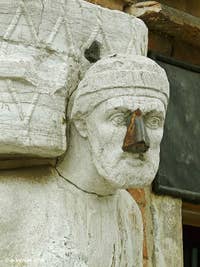
Antonio Rioba Mastelli with the iron nose On the other hand, the fact that in the same place there could have been a Fontego degli Arabi has never been proven.
Moreover, the latest research by Venice historians on the subject indicates that, in their opinion, there never was a Fontego degli Arabi in Venice as there was for the Germans (Le Fontego dei Tedeschi) or for the Turks (Le Fontego dei Turchi).
The correlation of this hypothetical Fontego degli Arabi with the very location of the Mastelli brothers' trading warehouses would therefore be completely unfounded.
And all the more so, given that the Mastelli brothers were not Arabs at all but were Greek, Christian, and in addition Venetian citizens members of the Grand Council of the Republic of Venice.
So it was with the Arab rumour concerning the Mastelli brothers, as it was with their statues, Islamised several centuries later....
Human-sized statues

The first Statue with a stole, a priest? The first statue, one and a half metres high, which stands at number 3384B in the Campo dei Mori, shows, due to the addition of the turban, a bearded Oriental holding a small coffret in his left hand.
.
But pay close attention and you'll also see that on this man's jacket is what could well be a religious stole, indicating that this character could just as easily have been a priest!
After all, the Mastelli family did take part in the Great Crusade against the infidels in 1202.
In fact, its owner at the time had it moved to dry land, to Spinea di Mestre, in his country house.
The statue returned to Venice during the twentieth century at a date that has remained undetermined.
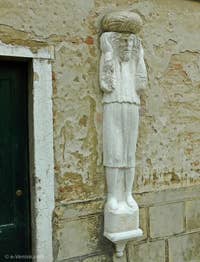
2nd statue at 3385 Campo dei Mori The second statue, one metre sixty seven high, is at number 3385.
This statue depicts a long-haired man carrying a burden on his shoulders with both hands.
The third statue, the most famous, to which the inscription Rioba was later added, is also the largest.
It measures one metre ninety in height.
It can be found at number 3386.
It is a man who is also carrying a burden, more precisely a sort of pan containing goods, a basket held to the wearer's forehead by a belt.
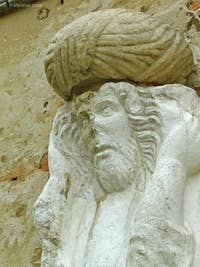
2nd statue at 3385 Campo dei Mori In one hand Rioba also holds, like one of his brothers, a small coffret, while in the other is still a stump of a staff.
The fourth statue stands separate from the other three.
It is located at 3397 on the Fondamenta dei Mori, against the house that became Tintoretto's.
At a height of one metre sixty five, it is thought to have belonged to the servant of the Mastelli brothers.
It is also the only statue to be completely set into the wall and moreover in a niche dating from the Renaissance, now particularly leaning!
It also sits on a carved stone column dating from the Roman period.
Christian Greeks who become Arabs only to end up being the laughing stock of the Venetians...
But the déboires of the Mastelli and their statues were to continue, and even after the family name was extinguished.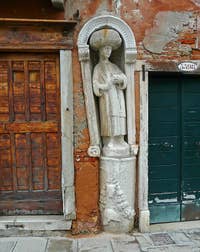
Statue of the servant of the Mastelli The Mastelli branch of Venice became extinct in 1620 with the death of the family's last male descendant: Antonio, son of Gaspare Mastelli and Laura Turioni.
It can therefore only be from this date that the statue in the corner on the Fondamenta dei Mori, that of Rioba, one of the first three Mastelli brothers, would have been renamed Sior Antonio Rioba instead of Rioba.
And so began the famous story of Antonio Rioba, Venetian Pasquino, the object of quips and jokes of varying degrees of wit until the last century, culminating in the replacement of the nose on the statue of Rioba Mastelli with an iron nose, between the end of the nineteenth and the beginning of the twentieth century.
Antonio Rioba, in competition with the Gobbo of the Rialto, but which had become one as early as 1577, thus also became an object of ridicule, a popular outlet.
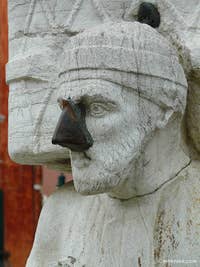
Sior Antonio Rioba, Venetian Pasquino Sior Antonio Rioba was then treated to Venetian-style pasquinades: peasants new to Venice or apprentices who were entrusted with parcels and letters to take to Sior Antonio Rioba, who was in Campo dei Mori.
Of course, poor Sior Antonio was unlikely to reply to the letters or acknowledge receipt of the packages.
On the other hand, there was always a crowd of onlookers and other laughers hanging around near the statue, watching the day's naïve arrivals and laughing at them!
The heyday of the pasquinade at Sior Antonio Rioba came in 1848, with a satirical publication that even bore his name.
From there several legends came to be grafted onto the poor Mastelli brothers.
They even gained a reputation as dishonest traders....
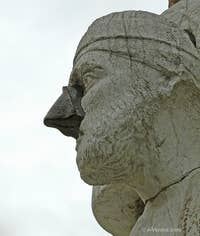
Sior Antonio Rioba, Venetian Pasquino Legend even has it that Saint Magdalene, disguised as a poor widow and having put their wickedness to the test, turned them into stone, which today explains their statufied presence in the campo dei Mori.
But here again, the peddlers of these legends have accumulated so many historical errors and contradictions about the Mastelli brothers that their tales seem to pale in comparison with the true story of these three brothers.
Three Greek merchants who managed to become Venetian citizens, to take part in the Great Crusade and the conquest of Constantinople with Doge Enrico Dandolo, and then to be members of the Grand Council of the Republic, that's still an exceptional destiny!
When you walk past them, don't forget to say hello and imagine those Greeks who came to settle so successfully in Venice, nine centuries ago now!
Squares Arsenal | Hunchback | Dogana | Colleoni | Rioba | Piazzetta St. Mark | Stefano | Rialto Vecchio
Back to Top of Page

